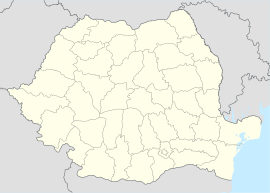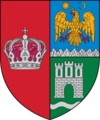
Brașov County is a county (județ) of Romania, in Transylvania. Its capital city is Brașov. The county incorporates within its boundaries most of the Medieval "lands" (țări) Burzenland and Făgăraș.

Piatra Neamț is the capital city of Neamț County, in the historical region of Western Moldavia, in northeastern Romania. Because of its very privileged location in the Eastern Carpathian mountains, it is considered one of the most picturesque cities in Romania. The Nord-Est Regional Development Agency is located in Piatra Neamț.
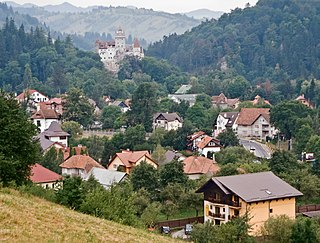
Bran is a commune in Brașov County, Transylvania, Romania. It is about 25 kilometres (16 mi) southwest of the city of Brașov and consists of five villages: Bran, Poarta, Predeluț (Kispredeál), Șimon (Simon), and Sohodol (Szohodol).

Negreni is a commune in Cluj County, Transylvania, Romania. It is composed of three villages: Bucea (Királyhágó), Negreni and Prelucele (Prelak). These were part of Ciucea Commune from 1968 to 2002, when they were split off.

The Piatra Craiului Mountains are a mountain range in the Southern Carpathians in Romania. Its name is translated as Kings' Rock or The Rock of the Prince. The mountain range is located in Brașov and Argeș counties; it is included in the Piatra Craiului National Park, which covers an area of 14,766 hectares (60 sq mi).

Dragoslavele is a commune in the northern part of Argeș County, Muntenia, Romania, located by the former border between Wallachia and Transylvania, on the Wallachian side. It is a relatively important location for boarding house tourism. The commune is composed of two villages, Dragoslavele and Valea Hotarului.

Rucăr is a commune located in the north-eastern part of Argeș County, Romania, situated in the Carpathian Mountains. The commune is composed of two villages, Rucăr and Sătic, and its population as of 2021 was 5,259. Historically important for its role as a border region between Wallachia and its neighboring countries, it is today popular with tourists from Bran Castle.
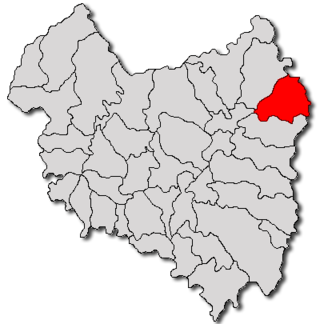
Brețcu is a commune in Covasna County, Transylvania, Romania composed of three villages: Brețcu, Mărtănuș (Kézdimartonos), and Oituz (Ojtoztelep). The village has been recorded under different names: Bereczk (1476), Breczko (1482–1496), Bretzku, and Bereck (1854).

Gheorghe Doja is a commune in Mureș County, Transylvania, Romania composed of five villages: Gheorghe Doja, Ilieni (Lukailencfalva), Leordeni (Lőrincfalva), Satu Nou (Teremiújfalu), and Tirimia (Nagyteremi).

Întregalde is a commune located in Alba County, Transylvania, Romania. It is composed of eleven villages: Dealu Geoagiului (Havasgyógy), Ghioncani, Iliești, Întregalde, Ivăniș, Mărinești, Modolești, Necrilești (Nekrilesti), Popești (Popesti), Sfârcea (Szfirecsea) and Tecșești (Teksesty).

Sălciua is a commune located in Alba County, Transylvania, Romania. It is composed of six villages: Dealu Caselor (Hegyik), Dumești, Sălciua de Jos, Sălciua de Sus (Felsőszolcsva), Sub Piatră (Búvópatak), and Valea Largă (Malompataka). It has a population of 1,271 as of 2021.
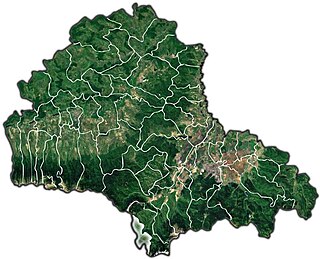
Fundata is a commune in Brașov County, Romania, in the historic region of Transylvania. It is composed of three villages: Fundata, Fundățica, and Șirnea. The place offers panoramas for the Piatra Craiului Mountains and Bucegi Mountains. During the 2013 European Youth Olympic Winter Festival, it held the biathlon competition in the new venue of the town.

Șinca is a commune in Brașov County, Transylvania, Romania. It is composed of six villages: Bucium (Bucsum), Ohaba (Ohába), Perșani (Persány), Șercăița (Sarkaica), Șinca Veche, and Vâlcea (Valcsatelep).

Șinca Nouă is a commune in Brașov County, Transylvania, Romania. It is composed of two villages, Paltin and Șinca Nouă, and also administers a hamlet, Strâmba.
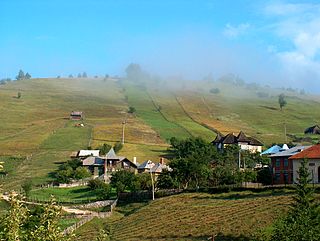
Dâmbovicioara is a commune in Argeș County, Muntenia, Romania. It is composed of three villages: Ciocanu, Dâmbovicioara, and Podu Dâmboviței.
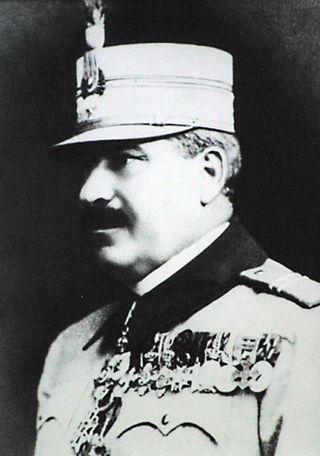
Traian Moșoiu was a Romanian general during World War I and the Hungarian–Romanian War. He held the posts of Minister of War in the Alexandru Vaida-Voevod cabinet, Minister of Communications and of Industry and Commerce in the Ion I. C. Brătianu cabinet.
The Battle of Zernest was fought on 11 August 1690, near the town of Zernest in southeastern Transylvania, between the allied forces of Transylvania and the Holy Roman Empire, and the allied forces of the Ottoman Empire, Tatar allies, Wallachians, and Hungarian Kurucs.

Ioan Bran de Lemény et Kozla, also known as Ioan Bran, was a lawyer, a revolutionary, and Transylvania's first Romanian civil servant. He was one of the organizers of the Romanian Legions and the captain of Fogaras County during the "liberal regime" (1861–1865).

St. George's Church is a Romanian Orthodox church located at 1 Piața Andrei Șaguna, Sfântu Gheorghe, Romania. It is dedicated to Saint George.

Piatra Craiului National Park is a protected area of national interest in Romania corresponding to IUCN category II, located on the territories of Argeș and Brașov counties. Located on the Piatra Craiului Massif, it is largely karstic.



